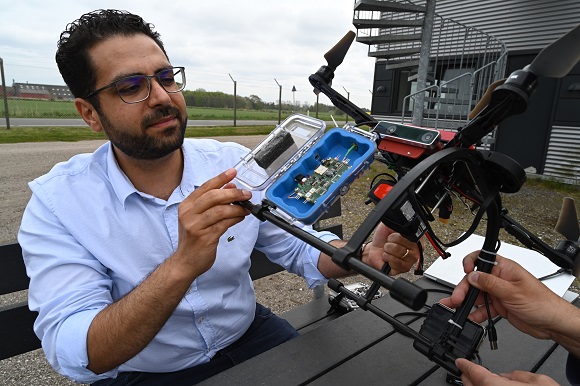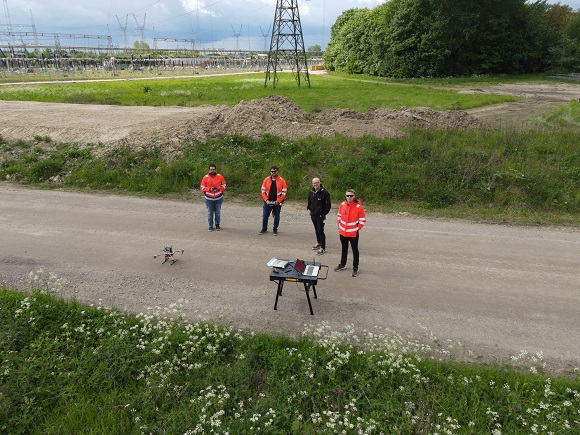
SDU charges drone on high voltage-line
Researchers from the Drone Center at SDU have for the first time in the world succeeded in connecting a drone directly to a high-voltage line with 150,000 volts in a test in central Odense, where it has taken new energy for its battery from the line.
The result opens for the use of drones for both inspection and other tasks directly on the 7000 km of high voltage lines. Thus, the national grid can be utilized to a greater extent than today, which can be of decisive importance for the green transition and the expansion of e.g. the wind turbine area in Denmark.
”We have just completed a test, where for the first time in the world we have connected a drone directly to a high voltage line with 150 kV (150,000 volts voltage, ed.), where it could charge the battery directly on the line. This is the first time we are testing on a real power line, after having tested the drone at HCA Airport for a long time.

Thus, the researchers and the project manager pick up where the drone colleagues from SDU recently left off when they released health drones in the air between Svendborg and Ærø for the first time.
First health drones - now energy drones
Last week, a partnership of researchers from SDU and medical doctors from OUH launched health drones for transporting blood samples and medicine on South Funen in the so-called Health Drone project. At the same time, EU Commissioner Elisa Ferreira visited a drone conference in Odense to hear more about the potential of the flying robots. Now, SDU researcher Emad Samuel Malki Ebeid and the rest of the team have launched another great bit of drone news into the air on Funen with a result which is definitely world news.
- So, in the future, a health drone, which has just started flying on South Funen, can connect to the energy network along the route if it needs more power when it has to fly far with a blood test or vital medicine, he states.

Three projects launched by SDU
The SDU drone has been developed in the project Drones4Energy, which has just been completed. The specially designed drone has for several years been tested and developed at the airport in collaboration with i.a. Energinet. The project, which was launched in 2018, has been followed by a new project called Drones4Safety. Here the focus is on inspecting bridges and railways, while the drone is charging the battery by connecting to the nearby power lines.
With last week's test, the researchers have demonstrated that the technology works, says the project manager.
- Now we have shown that we can land on the line and charge directly. This means that we can let swarms of autonomous drones place sensors and inspect the wires, which today must be disconnected and inspected by humans using lifts and helicopters, says Emad Samuel Malki Ebeid.
Better use of the grid
Today, Energinet, which is responsible for e.g. the 7000 km of high voltage power lines, has less than a handful of sensors on the grid. Using helicopters and lifts, the sensors are placed on the wires in parts of the grid that must first be disconnected for safety reasons. By leaving the interaction with the power lines to the drones, you can both avoid turning off the energy during installation and increase the monitoring of the network, because you can work with more sensors, and thus get a better use of the power lines.- Thus, among other things, we won’t need to decrease the power production from wind turbines for fear that the wires will be overloaded. This can increase the utilization of the grid by more than 20 percent, which is absolutely crucial if we are to increase the production of green electricity in Denmark, says the project manager.
At Energinet, Lars Rasmussen, who is responsible for e.g. inspections of the Danish high-voltage network, participated in the entire process. He backs up the SDU researcher.
- Today we are very careful about sending too much power through the lines, but with the help of the sensors we can get a better overview and constantly monitor how wind and weather affect the cables, which is very important for how we best utilize the capacity of the cables, he says.
From five meters to 60 cm
And not only can the partners now rejoice that the SDU-developed technology - unique in the world - enables the drone to land and charge directly on a high-voltage cable. They can carry out the inspections with far greater accuracy.Project manager Emad Samuel Malki Ebeid has just been visited by representatives of the EU's satellite project EGNOS. The European Geostationary Navigation Overlay Service (EGNOS) has been created to improve the accuracy and reliability of global navigation systems such as Galileo and GPS.
- They were here to take a closer look at the GPS receivers we use in our drone. The accuracy is between zero to five meters, so there can be a big difference between, for example, where exactly it inspects a bridge. If we use the EGNOS system, we can get within 60 centimeters, and that means a lot when inspecting a section of a bridge or placing a sensor on a high-voltage line, he says.
Emad Samuel Malki Ebeid and the two envoys from the EU-funded satellite program had expected that it would be necessary to replace the receivers, but it was enough to change the configuration, says an enthusiastic associate professor.
- So, we can use our existing receivers instead of buying new ones costing 10 times as much - or more than 1000 euros, he says.
Facts: Energy, safety and green conversion
- Since December 2018, the SDU UAS Center at the Maersk Mc-Kinney Møller Institute has been researching the use of drones for inspections of roads, bridges, and most recently high-voltage power lines.
- This has been done in the two projects Drones4Energy, which has just been completed, and Drones4Safety, which is a project under the EU Horizon 2020 program running until May 2023. Along the way, the partners have worked with autonomous drones, sensors, artificial intelligence and developed technology, so that the drone can charge directly on a high voltage line.
- Most recently, the UAS Center, led by Associate Professor Emad Samuel Malki Ebeid, has launched Drones4Green, which is the third step in the research work on using drones to secure the infrastructure in the Danish energy network with e.g. artificial intelligence and autonomous drones.
- The SDU researchers work in Drones4Green together with DTU and Aarhus University, but also have Energinet, the technology company Develco and Andel Energy on Sjælland as partners. Part of the work focuses on easing the green footprint by monitoring the status of the energy network in real time. This is done i.a. with the help of drones with a robot arm mounted and IoT solutions (Internet of Things, ed.), where you can use heat sensors and data to monitor and improve the use of the 7000 km of Danish high-voltage lines.
Meet the researcher
Emad Samuel Malki Ebeid has a PhD. from The University of Verona in Italy and is now an Associate Professor at the SDU UAS Centre at the Maersk Mc-Kinney Moller Institute. His area of research interests includes intelligent system design and heterogeneous embedded systems for aerial robotics. He is a Senior IEEE member and the project leader of the IFD Drones4Energy and EU H2020 Drones4Safety projects.